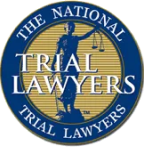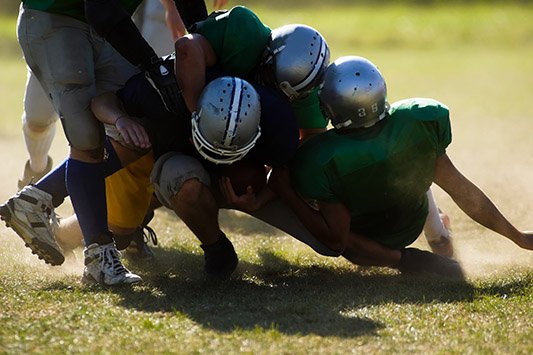
Today, there are pending concussion-related lawsuits against the NFL, NCAA and National Federation of State High School Associations (NFHS). Millions upon millions of dollars are being dedicated to medical research and improvements to helmets and other safety equipment. New rules are also being introduced at all levels of the sport on how to play the game and manage concussions to help prevent brain injury in football.
How did we get here? The following is a timeline look at major rules changes, equipment advances, medical research, legal action and other events that have helped to shape prevention of head and brain injury in football, one of the country’s most popular sports.
 A shoemaker in Annapolis, Maryland, creates the first leather football helmet. Admiral Joseph Mason Reeves wears the moleskin device in the Army-Navy game.
A shoemaker in Annapolis, Maryland, creates the first leather football helmet. Admiral Joseph Mason Reeves wears the moleskin device in the Army-Navy game.

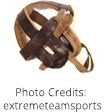 George Barclay of Lafayette College wears the first “head harness,” a leather helmet fixed to his head with three heavy straps to protect his head and ears.
George Barclay of Lafayette College wears the first “head harness,” a leather helmet fixed to his head with three heavy straps to protect his head and ears.

Vernon Wise, a 17-year-old at Oak Park High, dies from back injuries in a football game. His death generates heavy local press coverage. The Chicago Tribune calls the 1905 football season a “death harvest” as 18 players die in the U.S. School officials in Cook County, Illinois and across the country consider banning the sport.
President Theodore Roosevelt meets with Yale’s Walter Camp and others to discuss how to make the sport safer. The group creates rules that include setting first downs at 10 yards, creating a one-yard “neutral zone” at the line of scrimmage, mandating penalties for unsportsmanlike conduct and allowing the forward pass. These meetings lead to the establishment of the National Collegiate Athletic Association (NCAA).

Football deaths and injuries continue, including the death of University of Virginia halfback Archer Christian from head injuries suffered in a “line-bucking play.” New rules are adopted that include bans on line-bucking and “flying tackles.”

The first professional football organization is founded. It features 14 teams, including the Decatur Staleys (today’s Chicago Bears) and Chicago Cardinals (today’s Arizona Cardinals).
The group’s goals include raising “the standard of professional football in every way possible,” including prevention of injuries. Two years later, the group adopts the name, National Football League (NFL).

A New Jersey pathologist, Harrison Martland, is the first to describe in medical literature a condition called “punch drunk” syndrome or “dementia pugilistica.”
This is later known as chronic traumatic encephalopathy (CTE), a degenerative brain disease linked to concussions. CTE is later found in many former football players.

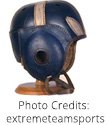 The John T. Riddell Company introduces the first all-plastic helmet. A chin strap is added to the design in 1940.
The John T. Riddell Company introduces the first all-plastic helmet. A chin strap is added to the design in 1940.
One major problem: The material is brittle and tends to break at impact.

The NFL requires all players to wear helmets. Six years later, the NFL officially adopts the plastic helmet.

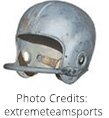 At halftime of a game, Cleveland Browns coach Paul Brown orders a bar to be added to the helmet of his star player, Otto Graham. It’s the first single-bar facemask.
At halftime of a game, Cleveland Browns coach Paul Brown orders a bar to be added to the helmet of his star player, Otto Graham. It’s the first single-bar facemask.
With money he earns from the patent, Brown creates the Cincinnati Bengals. By 1962, facemasks are worn by every NFL player.

The New England Journal of Medicine publishes a study which concludes that no football player should continue playing after suffering a third concussion.

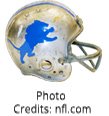 Riddell introduces “micro-fit technology” to helmets, which features padding inside that is aimed at absorbing blows to the head.
Riddell introduces “micro-fit technology” to helmets, which features padding inside that is aimed at absorbing blows to the head.
The NFL passes a rule that prohibits grabbing another player’s facemask. However, no penalties are attached to the rule until 1976. Those penalties include ejection for “vicious or flagrant” violations.

The National Operating Committee on Standards for Athletic Equipment (NOCSAE) is created to establish standards and certification of athletic equipment, including football helmets, in order to prevent injuries and deaths.

The NOCSAE publishes standards for football helmets. Companies that provide helmets to the NFL, college and high school sports teams release helmets to meet those standards.
By 1980, NOCSAE-certified helmets are required at every level of the sport.
The NCAA and NFHS adopt rules that ban “spearing,” or using the head as the initial contact point.

The NFL adopts the “Deacon Jones Rule,” which bans players from slapping an opponent’s helmet in an effort to get around them.

The NFL passes a rule that bans “spearing.” However, 17 years pass until referees are finally allowed to call personal fouls for helmet-to-helmet hits.

The NFL passes a rule that bans “spearing.” However, 17 years pass until referees are finally allowed to call personal fouls for helmet-to-helmet hits.

The National Center for Catastrophic Sport Injury Research is founded with funding, in part, from the American Football Coaches Association.
The center conducts vital research into fatal and non-fatal football injuries, including compiling statistics on brain injuries.

The first helmets made with polycarbonate alloy plastic and alloy steel face masks are introduced. They become standard equipment within a few years.

The NFL establishes the Mild Traumatic Brain Injury (MTBI) Committee to study concussions.
The committee releases studies that include a finding that team physicians had routinely allowed players with concussion symptoms to return to action, putting them at risk of suffering second impact syndrome.

In Lake County Circuit Court, a jury awards $1.55 million to former Chicago Bears fullback Merril Hoge in his lawsuit against a former team physician.
In his lawsuit, Hoge alleged that the doctor failed to warn him about the severity of his concussions, which forced him to retire at age 29.
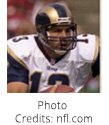 The Riddell Revolution helmet is introduced. It is specifically designed to reduce the risk of concussions and widely hailed as the biggest advance in helmet design in a quarter of a century.
The Riddell Revolution helmet is introduced. It is specifically designed to reduce the risk of concussions and widely hailed as the biggest advance in helmet design in a quarter of a century.
The “Revo” leads to “smart” helmets that include features that can monitor players for head injuries.

Dr. Bennet Omalu teams up with researchers from the University of Pittsburgh to publish the first of two controversial studies that discuss CTE among former football players.
The studies are influenced by autopsies of two former Pittsburgh Steelers, “Iron” Mike Webster and Terry Long.

The NFL Collective Bargaining Agreement includes the “88 Plan,” which provides medical benefits to former players who have developed dementia.

The NFL holds a summit that results in new guidelines for the management of concussions in the sport. Two years later, stricter guidelines are adopted.

The Center for the Study of Traumatic Encephalopathy (CSTE) is established in partnership with Boston University School of Medicine – the first center of its kind.

The NFHS makes changes to its rule book, stating that any athlete who “exhibits signs, symptoms or behaviors consistent with a concussion (such as loss of consciousness, headache, dizziness, confusion or balance problems) shall be immediately removed from the contest and shall not return to play until cleared by an appropriate health-care professional.”
The NFHS also issues new guidelines on management of concussions.

Before killing himself with a shotgun, former Chicago Bear defensive back Dave Duerson tells family members to donate his brain to the CSTE. Three months after his death, neurologists confirm that Duerson suffered from CTE.
The NCAA revises its 16-year-old guidelines on treatment of concussions to include language stating, “It is essential that no athlete be allowed to return to participation when any symptoms persist, either at rest or exertion.”

The NCAA adopts a new “targeting” rule that calls for ejecting players who target a defenseless player with a helmet-to-helmet hit. The controversial rule is revised a year later.
Alvin Jobe, the father of a Mississippi high school football player, files the first federal class-action lawsuit involving concussions suffered by high school football players. The lawsuit against the NCAA and NFHS includes a demand that both organizations certify concussion management plans of NFHS members.
The family of former San Diego Chargers linebacker Junior Seau releases the findings of a National Institutes of Health post-mortem examination of his brain, indicating that he suffered from CTE. Seau, like Duerson, had taken his own life with a shotgun in 2012.
The NFL reaches a proposed $765 million settlement of a lawsuit filed by a group of former players who claimed the league had concealed the dangers of concussions and rushed injured players back on the field. The plaintiffs included former Chicago Bears quarterback Jim McMahon and the family of Junior Seau. All 18,000 former NFL players could be eligible for compensation in the settlement, including those suffering from Alzheimer’s disease, CTE and dementia. The NFL also implements its strictest concussion protocol to date.

In the U.S. District Court for the Northern District of Illinois in Chicago, the NCAA submits a proposed $75 million settlement of claims brought by former athletes, including Eastern Illinois defensive back Adrian Arrington. The claims alleged that the NCAA endangered players’ health by putting concussion polices in the hands of its member schools. As part of the settlement, the NCAA would adopt new protocol for handling concussions and fund monitoring of former players. In the future, athletes could bring individual lawsuits against the NCAA but not class-action claims.
President Barack Obama hosts the first Healthy Kids and Safe Sports Concussion Summit at the White House. During the event, it is announced that organizations that include the NCAA, NFL and Department of Defense will spend millions of dollars on concussion research in the coming years.






